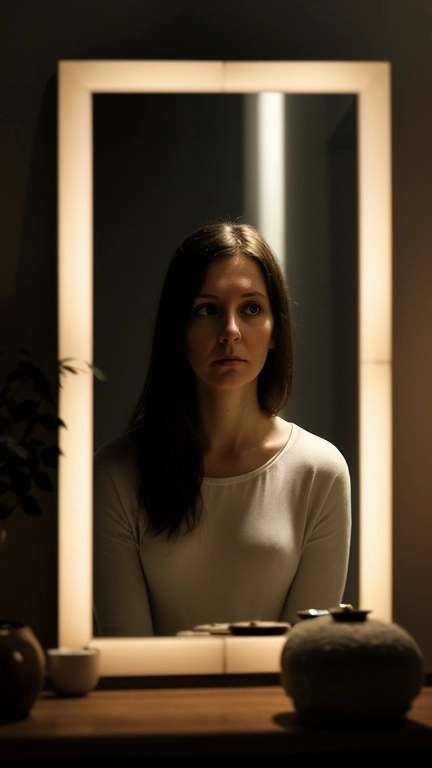Anxiety and depression: how to not create an illness out of natural emotions
Feeling sad or anxious is a natural emotional response when life is hard in one way or another. There’s nothing wrong with you if you have emotions like these.
On the contrary, there would be something wrong with you if you didn’t respond emotionally to things happening around you.
Yeah, but it still hurts, you know…
And that’s what matters, after all. Whether our problems are to be classified, formally, as sadness and stress or depression and anxiety isn’t important! Taking your emotions seriously is!
Understanding our situation always helps, however, so let’s try to determine what an illness is and what is not, why people’s attitudes make all of this complicated, and why it doesn’t matter much in the end.
(Featured image: Feeling sadness and anxiety are natural emotional responses – AI-generated illustration.)
What qualifies as an ‘illness’?
Formally, we suffer from an illness or ‘disorder’ if a healthcare professional has decided our situation fits in with a diagnosis found in their diagnostic manuals. For instance, the American Psychiatric Association’s diagnostic manual says that we have a disorder if:
- We suffer from something that causes significant disturbance in our behaviour, emotion, and cognition, and
- this is usually accompanied by significant distress that affects our work, school, and social relationships.
However, our daily use of words to describe our moods isn’t necessarily in line with those diagnostic manuals. And we don’t necessarily want a diagnosis, do we?
Reasons for understatement
I once heard an anecdote told with admiration by a GP operating a rural clinic in the Trøndelag region, Norway. One morning in the 1980s, an elderly man (probably my age) staggered into the doctor’s office and slumped into a chair. He didn’t seem to be well at all. “Are you in pain?” the doctor asked. “Yes, I think I can feel something today,” the man quietly replied after a while.
The examination showed the man had suffered a massive heart attack the night before, and he was rushed to the hospital.
This was how, ideally, you were supposed to handle pain in the culture I grew up in. This was how a ‘real man’ would behave. And we are still talking about a physical illness. A mental difficulty, even common problems such as anxiety and depression, wouldn’t be talked about at all.
As I’ve said in an earlier article, people would rather admit to having a syphilis diagnosis than a normal mental difficulty. The mental health shame was paralysing. I, for example, was paralysed enough by it to wait for 40 years before I started addressing my problems.

Reasons for overstatement
Luckily, the attitudes towards mental challenges have changed a lot in the later decades, at least in some cultures, especially among the younger generations.
It seems almost fashionable now, among some social media-based influencers, to talk a lot about their anxiety and depression. Sometimes, I wonder if their “I’m so depressed/anxious today” should have been “I feel sad/stressed today”. I can’t and won’t judge their experiences, but it’s not quite right if words like ‘depression’ and ‘anxiety’ (which can be severe conditions) are overused to such a degree that they lose their meaning.
However, we must take into account the cacophony of social media. There are so many competing voices. If you want to make your voice heard, you’ll often resort to speaking in bold or CAPITAL letters, or PREFERABLY BOTH. Under these conditions, it’s not surprising if people are “SO depressed” when they, in reality, are a bit sad.
Anyway:
The words don’t matter
Please don’t be confused by how people use words like ‘sad’, ‘low’, and ‘depressed’, or ‘stressed’, ‘scared’, and ‘anxious’. The words don’t matter, and people put such diverse meanings into them. And please don’t be restricted by what your culture allows you to show on the outside.
How you feel right now, inside, is what matters. Often, we don’t feel well, and there will be times we think:
Bloody emotions, I wish I didn’t have them
I know, I know. Sometimes, we want the emotions to go away, not to feel anything at all, to get a break. What are they good for anyway?

But what would life be without love, joy, hope, amusement, and, sometimes, awe? It’s the bad ones we’d rather get rid of, right? Such as fear, sadness, shame, guilt, and disappointment.
But they have all been built into us for good reasons. Have you ever noticed how quickly they kick in? Long before our logical brain has understood what is going on, had its internal discussions, and concluded, loooong before this, the emotions have taken control of our minds and, most likely, convinced us what to do after a fragment of a second. Even though it might go against what our logical left-hemisphere brain will say when it’s trying to catch up.
Both pleasant and unpleasant emotions are meant to be mental ‘shortcuts’ to make us respond quickly and (hopefully) correctly to incidents. Such as “God, there’s a lion behind us” (incident) -> fear (emotion) -> our bodies get ready for fight or flight (response). There is no reason to waste time contemplating this situation.
But these ‘mental shortcuts’ don’t always work very well, do they?
No, you’re right. I wrote above that emotions are supposed to make us respond “(hopefully) correctly” because evolution created emotions that work in most cases, not necessarily every time. Furthermore, they worked in most cases a long, long time ago. Evolution is a blind and slow process that rewards what increases the probability of passing our genes on. It’s so slow that we share most emotional responses with every other mammal. Evolution has probably just started to adapt to what’s happened in the last 10,000 years. That is, after the last ice age.
Some people ask why we complain so much about mental challenges now when life is so ‘easy’ (at least for most people in the Western world, compared to most people in the Western world just a few decades ago and basically everyone else).
I sincerely believe that much of the answer lies in the conflict between our ancient set of automatic emotions and the acceleratingly changing human society. For instance, both dogs and humans feel shame if they break the unspoken rules in their pack or family. The evolutionary lines of dogs and humans split up a hundred million years ago. That indicates how old an ‘invention’ an emotion like shame is.

I don’t think life in the modern, materialistically ‘rich’ Western world is necessarily as ‘easy’ as some people claim. Our emotional toolbox was constructed under severely different conditions than the overwhelmingly chaotic landscape of human interaction today.
Anyway, emotional responses have something important to tell us
Even when they don’t work to our advantage.
Losing something or someone we hold dear is supposed to make us sad. If we must handle more than we should have to handle, we’re supposed to feel stressed. If someone treats us unfairly, we’re supposed to feel angry. That’s how it should be. It’s okay.
Sadness helps us process our loss. Stress signals that we should slow down. Anger is our assistant when we need to defend ourselves and our boundaries.
When our emotions try to tell us something, we better listen and understand. Even when they suggest a one-hundred-million-year-old and totally misunderstood way of handling a modern-day situation. Because if we ignore and disregard our natural emotional responses to what happens around us, that’s precisely when we get into trouble.
It might not seem rational if we’re still grieving 10 years after our lovely German Shepherd, Trixie, died. We might not have any reason to feel sick and panic before presenting this month’s financial figures at work. Some might argue it’s an overreaction to feel angry when cousin Johnny hasn’t paid us back the £50 he owes us this month, as promised.
But the thing is, we are still grieving, we do panic before presentations, and it does p**s us off that cousin Johnny never keeps his promises.

What should we do, then? Act out every emotion we have?
Of course not. That would make us all act like toddlers.
But it is necessary to listen to our emotions (even when they seem irrational) and try to understand what they’re trying to tell us.
Sadness could tell us to take the time to grieve. Stress is a good indication that we need to slow down. Fear tells us to get out of the situation we’re in, at least for now, until we understand why we feel fear.
Ignoring and suppressing our emotions is not advisable. Because if we do, that’s when they start to get nasty. Snubbed emotions don’t go away, you know. They just brew and grow under the surface until one day, the perfectly normal sadness, stress, or fear has turned into a full-scale clinical depression or anxiety.
And you will know because now they will “cause significant disturbance in your behaviour, emotion and cognition, and cause significant distress that affects your work, school, and social relationships.”
Ask, “What are you trying to tell me?”
Feeling sad, scared, or stressed isn’t pleasant, but it’s not an illness. It’s a natural response to what’s happening around us. Still, taking our emotions seriously is essential, and taking action before they become illnesses is highly advisable. Just like it’s advisable to take a cut in my finger seriously before the wound gets infected.
And just like physical pain is there to warn us about physical injuries, most negative emotions are there to warn us about potential mental harm. Pain, both physical and mental, needs to be listened to and asked, “What are you trying to tell me?”
Trying to be like the man who “thought he felt something” after a massive heart attack, I ignored every physical and mental warning signal for 40 years, forever pushing on instead of listening to my body and mind. Not recommendable! I will probably have healing to work on for the rest of my life.
Well, at least this means I have interesting things to do as I grow older 🙂















Post Comment
You must be logged in to post a comment.